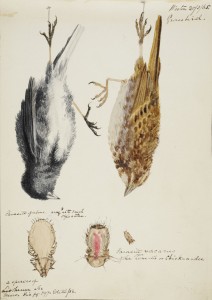The history of natural history and biology is heavily represented in the collection of the Osler Library, not just because of their important place in the history of medicine, but also in the life story of the library’s founder.

Coloured sketches by W. A. Johnson.
William Arthur Johnson Fonds, P139, Osler Library
William Osler (1849-1919) grew up in Bond Head, Ontario, surrounded by books. His father’s theological library had around 1,500 items. The young Osler had his first glimpse of a scientific library when he left home to attend Trinity College School (located today in Port Hope, Ontario). The Warden of the school, Reverend W.A. Johnson (1816-1889), according to Osler, “a good friend, botanist, a practical palaeontologist, an ardent microscopist,” inspired Osler with a passion for natural history.
While studying Anglican divinity at Trinity College, Toronto, Osler spent two years living with James Bovell, the Chair of Natural Theology at Trinity College and a member of the Toronto School of Medicine faculty, assisting him in his work. He would often go out to collect various samples of algae and other specimens to fix onto slides for Bovell. His first publication, “Christmas and the Microscope” (1869) demonstrated his love for and proficiency at microscopy. Osler transferred from Trinity College to the Toronto School of Medicine, and then ultimately to the Medical Faculty at McGill University to pursue the greater clinical opportunities available to medical students in Montreal.

Coloured sketches by W. A. Johnson.
William Arthur Johnson Fonds, P139, Osler Library
Osler’s affinity for natural history flourished during his stay at McGill. Through another mentor, Dr. Palmer Howard, Dean of the McGill Faculty of Medicine, Sir William was introduced to some of the foundational works in the field of life sciences, including those of Laennec, Stokes, and Graves. Osler’s thesis was based on the preparation of gross and microscopic slides from twenty autopsies. After graduation, he considered the India Medical Service, but opted to remain in Montreal, so as to pursue his work in microscopy. He was offered the Chair of Botany at McGill because of this expertise, but turned the position down in favour of a lectureship in Physiology. He became Chair of Clinical Medicine at the University of Pennsylvania in 1884, where he was a member of the Biology Club. His bibliophilia was inspired by places such as the College of Physicians in Philadelphia. Osler moved to the Johns Hopkins University in 1889, where in 1893 he played an instrumental role in the creation of the Johns Hopkins Medical School and teaching hospital. He was appointed Regius Professor of Medicine at Oxford University in 1905. At Oxford he served equally as a curator of the Bodleian Library and was heavily involved in the work of the Bibliographical Society of London. In Oxford, he had the leisure time to devote himself to his passion for book collecting, designing a library that would contain the most significant works produced in the history of medicine and science.
Come see a selection of works of natural history and biology in a special exhibition up now in the Osler Room of the Osler Library.

